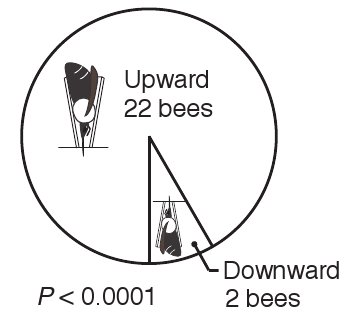Innate or learned preference for upward-facing flowers?: implications for the costs of pendent flowers from experiments on captive bumble bees
DOI:
https://doi.org/10.26786/1920-7603(2012)11Abstract
Pollinator preferences for phenotypic characters, including floral orientation, can affect plant reproductive success. For example, hawkmoths and syrphid flies prefer upward- over downward-facing flowers in field experiments. Although such preferences suggest a cost of pendent flowers in terms of pollinator attraction, we cannot rule out the possibility that the preferences have been affected by prior experience: pollinators might choose the same type of flowers to which they have already become accustomed. To test for innate preference, we observed bumble bees foraging on an array of upward- and downward-facing artificial flowers. Without any prior experience with vertical flowers, 91.7% bees chose an upward-facing flower at the very first visit. In addition to this innate preference, we also found that the preference was strengthened by experience, which suggests that the bees learned upward-facing flowers were easier to handle. Although bumble bees may concentrate on pendent flowers in the field, such learned preferences are evidently imposed on a template of upward-facing preference. Because bee-pollinated pendent flowers face particular difficulties in attracting visits, therefore, we expect them to compensate through other means, such as greater floral rewards.

Downloads
Published
How to Cite
Issue
Section
License
Copyright (c) 2012 Takashi T Makino, James D Thomson

This work is licensed under a Creative Commons Attribution 4.0 International License.
JPE is an open access journal which means that all content is freely available without charge to the user or his/her institution.
Authors who publish with this journal agree to the following terms:
1) Authors retain copyright and grant the journal right of first publication with the work simultaneously licensed under a Creative Commons Attribution License that allows others to share the work with an acknowledgement of the work's authorship and initial publication in this journal.
2) Authors are able to enter into separate, additional contractual arrangements for the non-exclusive distribution of the journal's published version of the work (e.g., post it to an institutional repository or publish it in a book), with an acknowledgement of its initial publication in this journal.
3) Authors are permitted and encouraged to post their work online (e.g., in institutional repositories or on their website) prior to and during the submission process, as it can lead to productive exchanges, as well as earlier and greater citation of published work (See The Effect of Open Access).
To assure a broader targeted audience, content will be included into databases (such as EBSCO) and directories (such as DOAJ).











